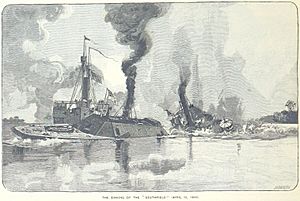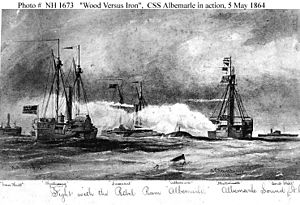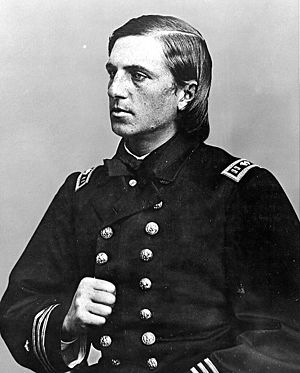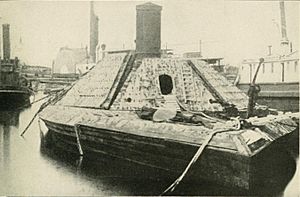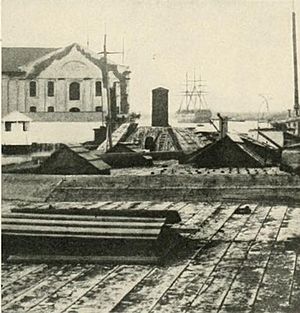CSS Albemarle facts for kids

A drawing of Albemarle
|
|
Quick facts for kids History |
|
|---|---|
| Name | Albemarle |
| Namesake | Albemarle Sound |
| Ordered | 16 April 1862 |
| Laid down | January 1863 |
| Commissioned | 17 April 1864 |
| Fate | 27 October 1864 sunk by spar torpedo, captured, raised, and sold |
| General characteristics | |
| Displacement | 376 tons |
| Length | 158 ft (48 m) |
| Beam | 35.4 ft (10.8 m) |
| Draught | 9 ft (2.7 m) |
| Propulsion | Steam |
| Speed | 4 knots (7.4 km/h; 4.6 mph) |
| Range | 120 miles, 193 km |
| Complement | 150 officers and men |
| Armament | two 6.4 Brooke double-banded rifles |
CSS Albemarle was a powerful warship from the American Civil War. It was a special kind of ship called a casemate ironclad ram. This meant it had strong iron armor and a pointy front (a ram) to crash into enemy ships. The Albemarle belonged to the Confederate Navy. Later, it was used by the United States Navy. It was named after Albemarle Sound, a large body of water in North Carolina. This sound was named after General George Monck, a famous person from long ago.
Contents
Building the Albemarle
On April 16, 1862, the Confederate Navy decided to build a new armored ship. They were very excited about how well their first ironclad, CSS Virginia, had done. That ship had beaten many wooden Union ships.
So, they hired a 19-year-old officer named Gilbert Elliott. He was put in charge of building a smaller, but still very strong, gunboat. This new ship was meant to destroy Union warships in the North Carolina sounds. These Union ships were helping Union soldiers control eastern North Carolina.
Gilbert Elliott chose a hidden spot to build the ship. It was in a cornfield along the Roanoke River, far from Union ships. A plantation owner, Peter Smith, helped him manage the building. The river there was too shallow for Union gunboats to reach. This kept the new ironclad safe while it was being built.
The Confederate Navy's main designer, John L. Porter, finished the ship's plans. The Albemarle had an armored casemate, which is like a strong, sloped bunker. It had eight sides, angled at 30 degrees. Inside this strong bunker were two large 6.4-inch (160 mm) Brooke pivot rifles. One was at the front and one at the back. Each cannon could fire from three different spots. Heavy iron shutters protected the cannons.
The ship was powered by two steam engines, each with 200 hp (150 kW). These engines turned two propellers. Construction started in January 1863 and continued for over a year. Union officers heard about the ship and worried. They asked the War Department to send soldiers to destroy it. But the Union Army never sent the troops. This turned out to be a big mistake.
Albemarle's Weapons
The Albemarle had two 6.4-inch (160 mm) Brooke rifled cannons. These cannons were very heavy, weighing over 12,000 pounds (5,400 kg) each. They were placed in the middle of the armored casemate, one at the front and one at the back.
Each cannon could turn to fire in a 180-degree arc, from one side of the ship to the other. This meant the Albemarle could fire both cannons at once from three different gun ports. The ship carried different types of ammunition. These included explosive shells, anti-personnel canister shot (like a giant shotgun blast), and grape shot. It also had special blunt-nosed, solid iron "bolts." These were early armor-piercing shots designed to break through enemy ship armor.
Battles on the Roanoke River
In April 1864, the new Confederate ship Albemarle was ready. Under Captain James W. Cooke, it sailed down the Roanoke River towards Plymouth, North Carolina. Its job was to clear the river of Union ships. This would help General Robert F. Hoke's soldiers attack the forts there.
The ship anchored a few miles from Plymouth. The pilot found that the river was high, and they could pass over Union obstacles. The Albemarle's armor kept it safe from the Union guns in the forts.
Soon, two Union paddle steamers, USS Miami and USS Southfield, came to attack. They were tied together to try and trap the Albemarle. Captain Cooke turned his ship sharply and rammed the Southfield. The ram got stuck in the Southfields hull, pulling the Albemarles front end down. As the Southfield sank, it rolled over, freeing the Albemarle.
While the Albemarle was stuck, the Miami fired a shell at it from very close. But the shell bounced off the Albemarle's sloped armor and hit the Miami instead. This killed the Miamis captain, Charles W. Flusser. The Miamis crew tried to board the Albemarle, but heavy gunfire drove them back. The Miami then escaped.
With the river clear, and with the Albemarle's cannons helping, General Hoke attacked. His troops captured Plymouth and the nearby forts.
On May 5, the Albemarle and a captured steamer called CSS Bombshell were sailing down the Roanoke River. They met eight Union warships in what became the Battle of Albemarle Sound. These Union ships had more than sixty cannons combined.
The Albemarle fired first, hitting the USS Mattabesett. It then tried to ram the Mattabesett, but the Union ship moved out of the way. The USS Sassacus then fired many heavy shots at the Albemarle. All of them bounced off its strong armor. However, the Bombshell was hit hard and quickly captured by Union forces.
Lieutenant Commander Francis Asbury Roe of the Sassacus decided to ram the Albemarle. The Sassacus hit the Albemarle directly on its side. This shattered the front of the Sassacus and got both ships stuck together. The Albemarles crew quickly fired two shells at point-blank range. One of them hit the Sassacuss boilers, causing steam to blast through the ship. The Sassacus managed to break free and drift away.
The Miami tried to use a spar torpedo and a net to disable the Albemarle, but neither worked. Over 500 shells were fired at the Albemarle during the battle. Even with some damage, the Albemarle sailed back up the Roanoke River to Plymouth.
The Sinking of the Albemarle
The Albemarle controlled the Roanoke River through the summer of 1864. By autumn, the U.S. government decided they had to destroy it. Lieutenant William B. Cushing came up with a plan. He found two small, fast steam launches (boats). He fitted each with a 12-pounder howitzer and a 14-foot (4.3 m) spar (a long pole) with a torpedo at the end. One boat was lost at sea, but the other arrived safely.
On the night of October 27, 1864, Cushing and his team began their mission. They quietly moved up the river. They planned to surprise and capture the Albemarle.
As they got close to the Confederate docks, they were spotted. Rifle and pistol fire came from the shore and the Albemarle. They also found that the ironclad was protected by floating logs. But the logs were slimy and the small boat rode right over them. Cushing pushed the spar with the torpedo against the Albemarle's hull. He then pulled a cord, setting off the torpedo.
The explosion threw Cushing and his men into the water. Cushing swam to shore and hid until daylight. He then stole a small boat and paddled slowly downriver to reach Union forces. It was a very dangerous journey, but he finally made it to safety. Cushing became a national hero for his brave act. Of his crew, one other man escaped, two drowned, and eleven were captured.
Cushing's daring raid blew a huge hole in the Albemarles hull. The ship sank immediately in the shallow river mud. Its upper part stayed mostly dry, and its Confederate flag still flew. The Confederate commander later saved both of the Albemarles cannons. He used them to defend Plymouth. The U.S. Navy honored Lieutenant Cushing's success with a special award.
Raising and Later Use
After Plymouth fell, the U.S. Navy raised the Albemarle. They fixed its hull temporarily. Near the end of the war, a Union gunboat towed the Albemarle to the Norfolk Navy Yard. It arrived there on April 27, 1865. The ship was repaired and finished on August 14, 1865.
The Albemarle was never used in battle again. It stayed at Norfolk until it was sold at a public auction on October 15, 1867. It was likely taken apart for its metal and parts. One of its 6.4-inch (160 mm) Brooke rifled cannons is now on display at the U.S. naval base in Norfolk, Virginia. Its smokestack is at the Museum of the Albemarle in Elizabeth City, North Carolina. The ship's bell is at the Port o' Plymouth Museum in Plymouth, North Carolina.
Replica of the Albemarle
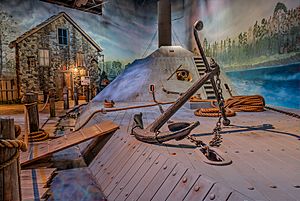
A smaller replica of the Albemarle has been in Plymouth, North Carolina, since April 2002. It is about 3/8 the size of the original, measuring 63-foot (19 m) long. This replica can move on its own and sail on the river. Every year, it goes out on the water during the Living History Weekend in late April.
See also
- Ships captured in the American Civil War
- Bibliography of American Civil War naval history



